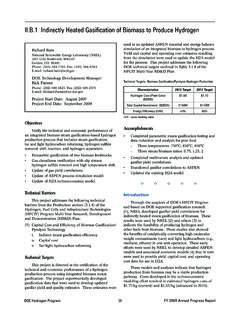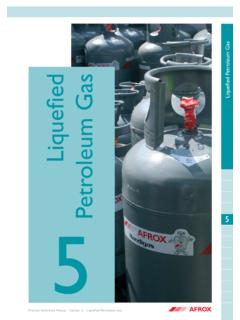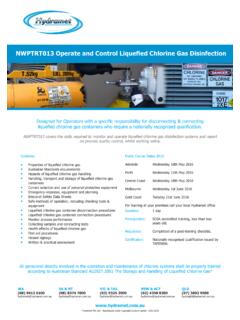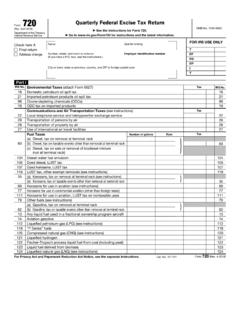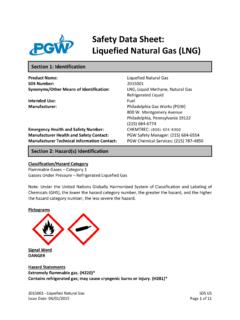Transcription of DOE Hydrogen and Fuel Cells Program Record
1 1 DOE Hydrogen and Fuel Cells Program Record Record #: 9013 Date: July 7th, 2009 Title: Energy requirements for Hydrogen gas compression and liquefaction as related to vehicle storage needs Originator: Monterey Gardiner Approved by: Sunita Satyapal Date: October 26th, 2009 Item: This Record addresses the range of energy requirements to compress and/or cool Hydrogen (H2) for storage onboard a Hydrogen vehicle. Two physical Hydrogen storage methods are considered: H2 gas compressed to high pressure (350, 700 bar) and liquid Hydrogen (LH2). Theoretical minimum energy requirements are determined from exergy differences using the standard properties of normal Hydrogen (25% para-H2 spin isomer) as reported by the National Institute of Standards (NIST) [1]. In all cases it is assumed that H2 gas is initially generated at 20 bar (290 psia). The theoretical energy to compress Hydrogen isothermally from 20 bar to 350 bar (5,000 psi or ~35 MPa) is kWh/kg H2 and only kWh/kg H2 for 700 bar (10,000 psi or ~ 70 MPa).
2 Greater compression energies are required to fill vehicles in practice due to compressor inefficiencies and heating during fast fills. DOE Technology Validation Project data for compression from on-site H2 production is to kWh/kgH2 [ 2]. Additional energy required for pre-cooling (as cold as -40 C)[3] to ensure on board fast fill temperatures are 85 C or lower can be modest ( kWh/kg H2)[4] . The minimum theoretical energy to liquefy Hydrogen from ambient (300 K, bar) conditions is kWh/kg LH2 or kWh/kg LH2 with conversion to para-LH2 (which is standard practice) [1]. Actual liquefaction energy requirements are substantially higher, typically 10-13 kWh/kg LH2, depending on the size of the liquefaction operation [5,6]. Novel liquefaction methods such as an active magnetic regenerative liquefier may require as little as 7 kWh/kg LH2 [ 6,7]. For comparison, the lower heating value (LHV) of Hydrogen is kWh/kg H2.
3 Compression energy requirements from on-site production range from approximately 5 - 20% of LHV. Liquefaction (including conversion to para-LH2) with today s processes requires 30 - 40% of LHV, while theoretical energy requirements for 700 bar and LH2 storage span a range of only 4-10% of LHV respectively. Background: The majority of Hydrogen vehicles on the road today store H2 gas in fiber composite wrapped pressure vessels with service pressures of 350 bar (5,000 psi). Some vehicles store H2 in vessels with service pressures as high as 700 bar (10,000 psi) or store cryogenic LH2 at low pressure (2-4 bar). High pressure vessels are required to have a factor of safety of (US) to (EU) [8]. Reducing the energy for compression, cooling and/or liquefaction of H2 for storage can help minimize the upstream energy consumption of Hydrogen vehicles. 2 Due to compression heating, overpressures are required to achieve a complete fill when rapidly refueling with high pressure H2 gas.
4 A 350 bar system can require an overpressure as high as 440 bar and the maximum vessel temperature must be limited to 85 o. Pre-cooling is not usually needed for 350 bar fills of 5 kg H2 in less than 5 minutes. Several factors contribute to the need for pre-coolng. Some examples are ambient temperature, tank capacity, design, and vessel Type. Aluminum lined Type III vessels have faster heat transfer from the warm gas and more heat capacity than Type IV vessels with polymer liners. The latest draft of the document SAEJ2601 (Compressed Hydrogen Vehicle Fueling Communication Device) lists precooling for 350 bar vehicles. 700 bar fast fill systems can require an overpressure as high as 880 bar with pre-cooling as low as -40o C (233 Kelvin) [3]. Data and Assumptions: This Record presents theoretical minimum, estimated, and reported energy requirements to refuel automobiles storing H2 gas at 350 bar or 700 bar, as well as cryogenic LH2.
5 Theoretical calculations assume H2 generated at 20 bar (290 psi) and 300 Kelvin before it is compressed and/or liquefied . If H2 were only available at ambient conditions (1 atm, 300 Kelvin), an additional theoretical minimum of kWh/kg H2 would be required. In practice, considerably more energy is required for mechanical compression from ambient conditions to 20 bar. Table 1 (with references) presents the energy required for storage of Hydrogen at three different conditions (350 bar, 700 bar, 1 bar at 20 Kelvin). Of particular note are the very modest theoretical storage energies. Compressing Hydrogen (isothermally) from 20 bar to 350 bar requires just kWh/kg H2, with an additional kWh/kg H2 to reach a refueling pressure of 440 bar. Only kWh/kg H2 is required for compression to 700 bar, with an additional kWh/kg H2 to reach a refueling pressure of 880 bar. Beginning with 20 bar H2 gas, liquefaction adds a theoretical minimum work of only kWh/kg LH2.
6 An additional, kWh/kg LH2 minimum theoretical work is necessary for conversion of equilibrium Hydrogen forms (75 % ortho and 25% para) at room temperature to equilibrium Hydrogen forms ( + para) at 20 Kelvin[6]. If this were not done, slow conversion of the 75% ortho-H2 to para-H2, would generate heat sufficient to evaporate the liquid Hydrogen . Currently, Hydrogen is typically compressed by a reciprocal compressor. At the flow rates and pressures for 1,000 kg/day Hydrogen refueling stations, these compressors can achieve an isentropic efficiency of about 56% and a motor efficiency of 92% [5]. Using these values, the H2A Delivery Scenario Model (HDSAM) projects a refueling station compression energy efficiency of 52% to fill 350 and 49% for 700 bar vehicles. This corresponds to an energy use of and kWh/kg H2 for compression to 440 bar and 880 bar respectively [9]. The HDSAM model estimates the need for kWh/kg H2 for cooling to -40o C for the 700 bar fill.
7 Existing DOE Technology Validation Hydrogen demonstration refueling sites have experienced an average compression energy of kWh/kg H2 [ 2]. There is a wide range in this data ( kWh/kg H2), likely due to the different types of compressors in use and a range of refueling conditions for these demonstrations. If one removes the outliers and focuses on 350 bar, the range narrows to 3 2 to 4 kWh/kg H2. Air Products and Chemicals Inc. (APCI) estimates the need for kWh/kg compression energy to 880 bar. They estimate the precooling energy required to cool Hydrogen from 30o C to -20o C for a 700 bar refueling to be kWh/kg H2 [10]. Hydrogen liquefaction involves multiple process steps and some degree of complexity in addition to compression. This leads to significantly higher energy requirements and a broader range of actual energy requirements which vary with liquefaction plant scale. Peschka [6] estimates an energy requirement of 10 kWh/kg LH2 for a conventional LH2 plant with improvements in compression and turbine efficiencies.
8 Bracha shows as much as kWh/kg LH2 for liquefaction at small industrial scales [11] . Discussions with industrial gas companies led to an estimated range of 8-12 kWh/kg LH2 for new plants with capacities of 5,000-200,000 kg LH2/da y[5]. The largest liquefier in operation in the US today is about 55,000 kg LH2 / day[10] Current research shows a strong potential to achieve 7 kWh/kg LH2 based on active magnetic regenerative liquefiers[7]. The technology is potentially capable of lower costs than conventional liquefaction plants especially at small liquefaction scales (2,000 to 5,000 kg LH2/day) [ 7] . References: [1] NIST Web book site: [2] NREL Composite Data Products from the DOE Tech Validation Program Refueling Station Compressor Efficiency, CDP #61, 3/2/09 Reported average efficiency of kWh/kg for 1 quarter reported data for on site Hydrogen generation with a range of 7 to 16 MJ/kg (2 to 4 kWh/kg) excluding outliers [3] Next Energy 70 MPa Specification Documents: Specification for 70 MPa Compressed Hydrogen Vehicles Release Version [4] Technical Assessment of Compressed Hydrogen Storage for Automotive Applications TIAX LLC, Argonne National Laboratory, 2009 #h2_storage [5] Report: H2A Hydrogen Delivery Infrastructure Analysis Models and Conventional Pathway Options Analysis Results , May 2008, [6] Peschka, W.
9 (1992). Liquid Hydrogen . Springer-Verlag, New York. [7] Active Magnetic Regenerative Liquefier, John Barclay, Prometheus Energy DOE Annual Merit Review, May 2009 [8] DOE, Website on Tank Safety. 4 DOT Factor of Safety, Table 4: Hydrogen Cylinder Test Matrix P. 6 EU Factor of Safety Table : Minimum Burst Pressure Ratios P. 59-60, [9] DOE Hydrogen Delivery Website and Model ( HDSAM ) [10] Personal communication with Joseph P. Cohen at APCI. Assuming a normal compressor, and typical ambient temperature conditions compression energy is: for 350(440) bar, for 500(630) bar, and for 700(880) bar. Cooling energy ranges from to .45 kWh/kg. Cooling energy from 30 C ambient to -40 C and -20 C is , kWh/kg. Cooling energy from 15 C ambient to -40 C and -20 C is , kWh/kg. Typically no cooling is needed for 350 bar. The APCI, Hydrogen liquefier in New Orleans is sized for approximately 55,000 kg/day.
10 [11] M Bracha, et al., Large-Scale Hydrogen Liquefaction in Germany International Journal of Hydrogen Energy 19 (Jan 1994) pp. 53-59. 5 6 Table 1 Color kWh/kg [Reference] Notes: theoretical minimum energies are in addition to kWh/kg H2 needed to reach 20 bar, 300 Kelvin LH2 20K, 2- 4 bar Actual [11] Existing Small Plant (4,400 kg/day) [4] Existing Medium Scale (<50,000 kg/day) [4] Projected Large Scale (200,000 kg /day) [6] Projected for Magnetic Liquefaction Theoretical [1] Conversion to 99%+ Liquid para Hydrogen [1] Normal Liquid Hydrogen (25% para) 350 bar Actual 2, , 4[2] Tech Val Program : Compression Energy from On-site Production H2.: Low, Average, and High 700 bar with fast fill to 880 bar Actual [9] H2A Projection for Compression and Cooling from 25 C to -40 C (233K) ( + kWh/kg) [10] Air Products for Compression and Cooling from 30 C to -20 C (253K) ( + kWh/kg) Theoretical [1]1 To 880 bar, 300K [1] To 700 bar, 300K 350 bar with fast fill to 440 bar Actual [9] H2A Projected for Compression to 440 bar [10] Air Products estimate for Compression to 440 bar Theoretical [1] To 440 bar, 300K [1] To 350 bar, 300K


